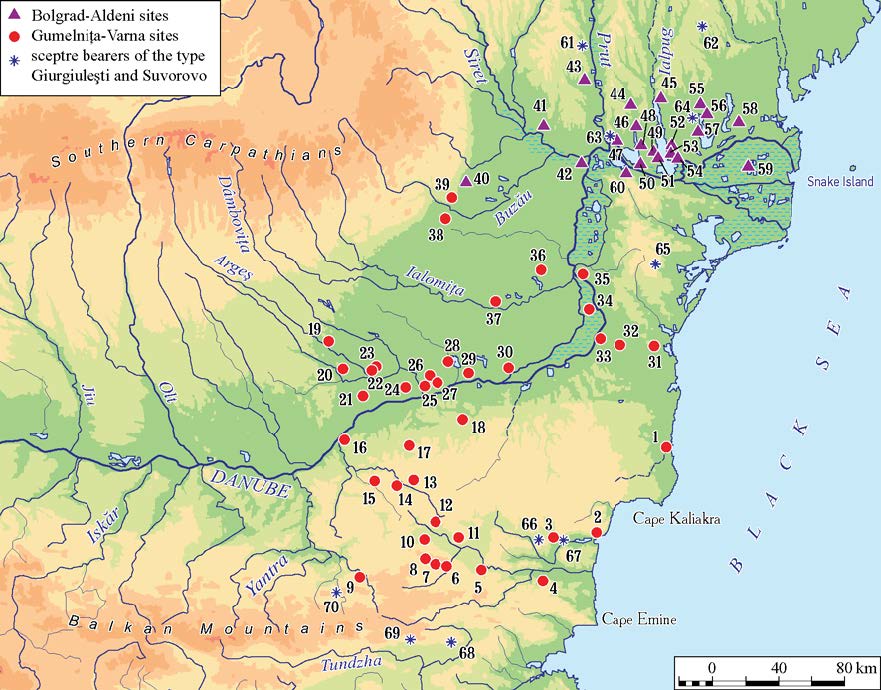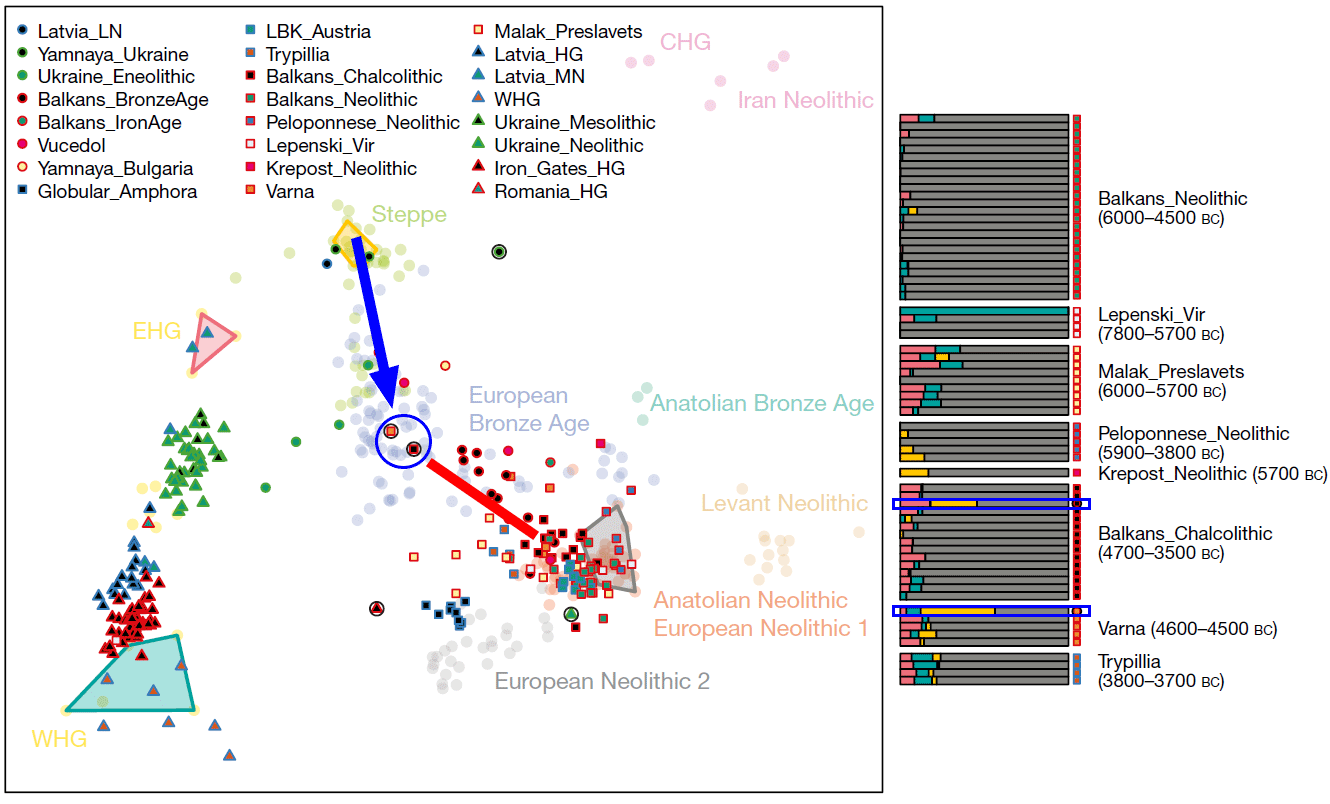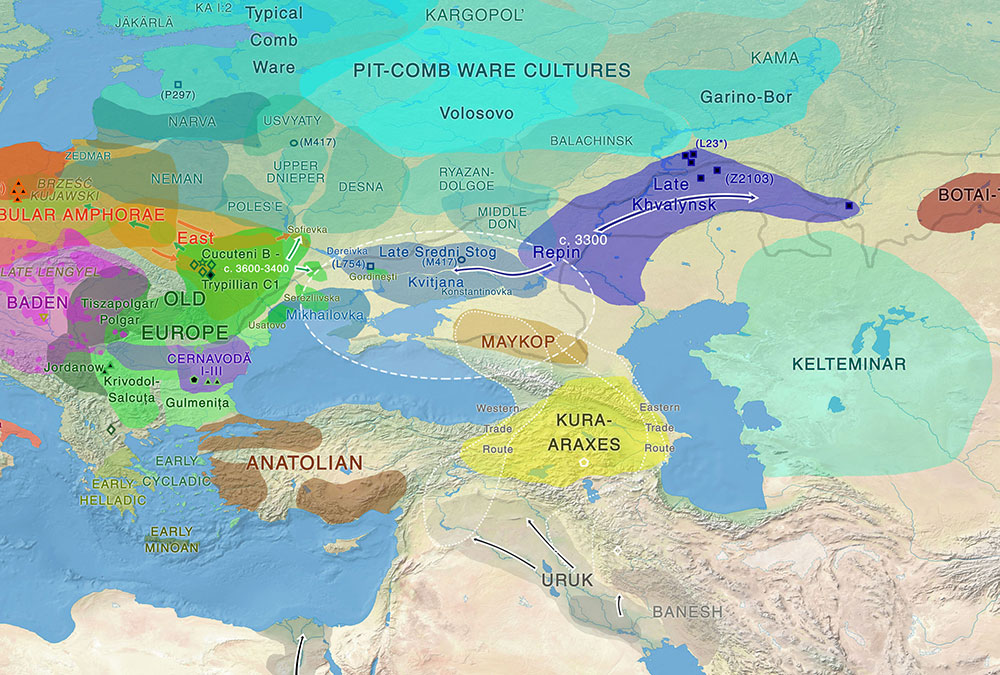This is part I of two posts on the most recent data concerning the earliest known Indo-European migrations.
Anatolian in Armi
I am reading in forums about “Kroonen’s proposal” of Anatolian in the 3rd millennium. That is false. The Copenhagen group (in particular the authors of the linguistic supplement, Kroonen, Barjamovic, and Peyrot) are merely referencing Archi (2011. “In Search of Armi”. Journal of Cuneiform Studies 63: 5–34) in turn using transcriptions from Bonechi (1990. “Aleppo in età arcaica; a proposito di un’opera recente”. Studi Epigrafici e Linguistici sul Vicino Oriente Antico 7: 15–37.), who asserted the potential Anatolian origin of the terms. This is what Archi had to say about this:
Most of these personal names belong to a name-giving tradition different from that of Ebla; Arra-ti/tulu(m) is attested also at Dulu, a neighbouring city-state (Bonechi 1990b: 22–25).28 We must, therefore, deduce that Armi belonged to a marginal, partially Semitized linguistic area different from the ethno-linguistic region dominated by Ebla. Typical are masculine personal names ending in -a-du: A-la/li-wa-du/da, A-li/lu-wa-du, Ba-mi-a-du, La-wadu, Mi-mi-a-du, Mu-lu-wa-du. This reminds one of the suffix -(a)nda, -(a)ndu, very productive in the Anatolian branch of Indo-European (Laroche 1966: 329). Elements such as ali-, alali-, lawadu-, memi-, mula/i- are attested in Anatolian personal names of the Old Assyrian period (Laroche 1966: 26–27, 106, 118, 120).

This was used by Archi to speculatively locate the state of Armi, in or near Ebla territory, which could correspond with the region of modern north-western Syria:
The onomastic tradition of Armi, so different from that of Ebla and her allies (§ 5), obliges us to locate this city on the edges of the Semitized area and, thus, necessarily north of the line running through Hassuwan – Ursaum – Irritum – Harran. If Armi were to be found at Banat-Bazi, it would have represented an anomaly within an otherwise homogenous linguistic scenario.34
Taken as a whole, the available information suggests that Armi was a regional state, which enjoyed a privileged relationship with Ebla: the exchange of goods between the two cities was comparable only to that between Ebla and Mari. No other state sent so many people to Ebla, especially merchants, lú-kar. It is only a hypothesis that Armi was the go-between for Ebla and for the areas where silver and copper were extracted.
This proposal is similar to the one used to support Indo-Aryan terminology in Mittanni (ca. 16th-14th c. BC), so the scarce material should not pose a problem to those previously arguing about the ‘oldest’ nature of Indo-Aryan.
NOTE. On the other hand, the theory connecting ‘mariannu‘, a term dated to 1761 BC (referenced also in the linguistic supplement), and put in relation with PIIr. *arya–, seems too hypothetical for the moment, although there is a clear expansion of Aryan-related terms in the Middle East that could support one or more relevant eastern migration waves of Indo-Aryans from Asia.
Potential routes of Anatolian migration
Once we have accepted that Anatolian is not Late PIE – and that only needed a study of Anatolian archaisms, not the terminology from Armi – , we can move on to explore the potential routes of expansion.
On the Balkan route
A current sketch of the dots connecting Khvalynsk with Anatolia is as follows.

First, we have the early expansion of Suvorovo chieftains spreading from ca. 4400-4000 BC in the lower Danube region, related to Novodanilovka chiefs of the North Pontic region, and both in turn related to Khvalynsk horse riders (read a a recent detailed post on this question).
Then we have Cernavoda I (ca. 3850-3550 BC), a culture potentially derived from the earlier expansion of Suvorovo chiefs, as shown in cultural similarities with preceding cultures and Yamna, and also in the contacts with the North Pontic steppe cultures (read a a recent detailed post on this question).
We also have proof of genetic inflow from the steppe into populations of cultures near those suggested to be heirs of those dominated by Suvorovo chiefs, from the 5th millennium BC (in Varna I ca. 4630 BC, and Smyadovo ca. 4500 BC, see image below).
If these neighbouring Balkan peoples of ca. 4500 BC are taken as proxies for Proto-Anatolians, then it becomes quite clear why Old Hittite samples dated 3,000 years after this migration event of elite chiefs could show no or almost no ancestry from Europe (for this question, read my revision of Lazaridis’ preprint).
NOTE. A full account of the crisis in the lower Danube, as well as the Suvorovo-Novodanilovka intrusion, is available in Anthony (2007).

The southern Balkans and Anatolia
The later connection of Cernavoda II-III and related cultures (and potentially Ezero) with Troy, on the other hand, is still blurry. But, even if a massive migration of Common Anatolian is found to happen from the Balkans into Anatolia in the late 4th / beginning of the 3rd millennium, the people responsible for this expansion could show a minimal trace of European ancestry.
A new paper has appeared recently (in Russian), Dubene and Troy: Gold and Prosperity in the Third Millennium Cal. BCE in Eurasia. Stratum Plus, 2 (2018), by L. Nikolova, showing commercial contacts between Troy and cultures from Bulgaria:
Earlier third millennium cal BCE is the period of development of interconnected Early Bronze Age societies in Eurasia, which economic and social structures expressed variants of pre-state political structures, named in the specialized literature tribes and chiefdoms. In this work new arguments will be added to the chiefdom model of third millennium cal BC societies of Yunatsite culture in the Central Balkans from the perspectives of the interrelations between Dubene (south central Bulgaria) and Troy (northwest Turkey) wealth expression.
Possible explanations of the similarity in the wealth expression between Troy and Yunatsite chiefdoms is the direct interaction between the political elite. However, the golden and silver objects in the third millennium cal BCE in the Eastern Mediterranean are most of all an expression of economic wealth. This is the biggest difference between the early state and chiefdoms in the third millennium cal BCE in Eurasia and Africa. The literacy and the wealth expression in the early states was politically centralized, while the absence of literacy and wider distribution of the wealth expression in the chiefdoms of the eastern Mediterranean are indicators, that wider distribution of wealth and the existed stable subsistence layers prevented the formation of states and the need to regulate the political systems through literacy.
The only way to link Common Anatolians to their Proto-Anatolian (linguistic) ancestors would therefore be to study preceding cultures and their expansions, until a proper connecting route is found, as I said recently.
These late commercial contacts in the south-eastern Balkans (Nikolova also offers a simplified presentation of data, in English) are yet another proof of how Common Anatolian languages may have further expanded into Anatolia.
NOTE. One should also take into account the distribution of modern R1b-M269* and L23* subclades (i.e. those not belonging to the most common subclades expanding with Yamna), which seem to peak around the Balkans. While those may just belong to founder effects of populations preceding Suvorovo or related to Yamna migrants, the Balkans is a region known to have retained Y-DNA haplogroup diversity, in contrast with other European regions.
On a purely linguistic aspect, there are strong Hattic and Hurrian influences on Anatolian languages, representing a unique layer that clearly differentiates them from LPIE languages, pointing also to different substrates behind each attested Common Anatolian branch or individual language:
- Phonetic changes, like the appearance of /f/ and /v/.
- Split ergativity: Hurrian is ergative, Hattic probably too.
- Increasing use of enclitic pronoun and particle chains after first stressed word: in Hattic after verb, in Hurrian after nominal forms.
- Almost obligatory use of clause initial and enclitic connectors: e.g. semantic and syntactic identity of Hattic pala/bala and Hittite nu.
NOTE. For a superficial discussion of this, see e.g. An Indo-European Linguistic Area and its Characteristics: Ancient Anatolia. Areal Diffusion as a Challenge to the Comparative Method?, by Calvert Watkins. You can also search for any of the mentioned shared isoglosses between Middle Eastern languages and Anatolian if you want more details.
On the Caucasus route
It seems that the Danish group is now taking a stance in favour of a Maykop route (from the linguistic supplement):
The period of Proto-Anatolian linguistic unity can now be placed in the 4th millennium BCE and may have been contemporaneous with e.g. the Maykop culture (3700–3000 BCE), which influenced the formation and apparent westward migration of the Yamnaya and maintained commercial and cultural contact with the Anatolian highlands (Kristiansen et al. 2018).
In fact, they have data to support this:
The EHG ancestry detected in individuals associated with both Yamnaya (3000–2400 BCE) and the Maykop culture (3700–3000 BCE) (in prep.) is absent from our Anatolian specimens, suggesting that neither archaeological horizon constitutes a suitable candidate for a “homeland” or “stepping stone” for the origin or spread of Anatolian Indo- European speakers to Anatolia. However, with the archaeological and genetic data presented here, we cannot reject a continuous small-scale influx of mixed groups from the direction of the Caucasus during the Chalcolithic period of the 4th millennium BCE.
While it is difficult to speak about the consequences of this find without having access to this paper in preparation or its samples, we already knew that Maykop had obvious cultural contacts with the steppe.
It will not be surprising to find not only EHG, but also R1b-L23 subclades there. In my opinion, though, the most likely source of EHG ancestry in Maykop (given the different culture shown in other steppe groups) is exogamy.
The question will still remain: was this a Proto-Anatolian-speaking group?

My opinion in this regard – again, without access to the study – is that you would still need to propose:
- A break-up of Anatolian ca. 4500 BC represented by some early group migrating into the Northern Caucasus area.
- For this group – who were closely related linguistically and culturally to early Khvalynsk – to remain isolated in or around the Northern Caucasus, i.e. somehow ‘hidden’ from the evolving LPIE speakers in late Khvalynsk/early Yamna peoples.
- Then, they would need to have migrated from Maykop to Anatolian territory only after ca. 3700 BC – while having close commercial contacts with Khvalynsk and the North Pontic cultures in the period 3700-3000 BC -, in some migration wave that has not showed up in the archaeological records to date.
- Then appear as Old Hittites without showing EHG ancestry (even though they show it in the period 3700-3000 BC), near the region of the Armi state, where Anatolian was supposedly spoken already in the mid-3rd millennium.
Not a very convincing picture, right now, but indeed possible.
Also, we have R1b-Z2103 lineages and clear steppe ancestry in the region probably ca. 2500 BC with Hajji Firuz, which is most likely the product of the late Khvalynsk migration waves that we are seeing in the recent papers.
These migrations are then related to early LPIE-speaking migrants spreading after ca. 3300 BC – that also caused the formation of early Yamna and the expansion of Tocharian-related migrants – , which leaves almost no space for an Anatolian expansion, unless one supports that the former drove the latter.
NOTE. In any case, if the Caucasus route turned out to be the actual Anatolian route, I guess this would be a way as good as any other to finally kill their Indo-European – Corded Ware theory, for obvious reasons.
On the North Iranian homeland
A few thoughts for those equating CHG ancestry in IE speakers (and especially now in Old Hittites) with an origin in North Iran, due to a recent comment by David Reich:
In the paper it is clearly stated that there is no Neolithic Iranian ancestry in the Old Hittite samples.
Ancestry is not people, and it is certainly not language. The addition of CHG ancestry to the Eneolithic steppe need not mean a population or linguistic replacement. Although it could have been. But this has to be demonstrated with solid anthropological models.
NOTE. On the other hand, if you find people who considered (at least until de Barros Damgaard et al. 2018) steppe (ancestry/PCA) = Indo-European, then you should probably confront them about why CHG in Hittites and the arrival of CHG in steppe groups is now not to be considered the same, i.e why CHG / Iran_N ≠ PIE.
Since there has been no serious North Iranian homeland proposal made for a while, it is difficult to delineate a modern sketch, and I won’t spend the time with that unless there is some real anthropological model and genetic proof of it. I guess the Armenian homeland hypothesis proposed by Gamkrelidze and Ivanov (1995) would do, but since it relies on outdated data (some of which appears also in Gimbutas’ writings), it would need a full revision.
NOTE. Their theory of glottalic consonants (or ejectives) relied on the ‘archaism’ of Hittite, Germanic, and Armenian. As you can see (unless you live in the mid-20th century) this is not very reasonable, since Hittite is attested quite late and after heavy admixture with Middle Eastern peoples, and Germanic and Armenian are some of the latest attested (and more admixed, phonetically changed) languages.
This would be a proper answer, indeed, for those who would accept this homeland due to the reconstruction of ‘ejectives’ for these languages. Evidently, there is no need to posit a homeland near Armenia to propose a glottalic theory. Kortlandt is a proponent of a late and small expansion of Late PIE from the steppe, and still proposes a reconstruction of ejectives for PIE. But, this was the main reason of Gamkrelidze and Ivanov to propose that homeland, and in that sense it is obviously flawed.
Those claiming a relationship of the North Iranian homeland with such EHG ancestry in Maykop, or with the hypothetic Proto-Euphratic or Gutian, are obviously not understanding the implications of finding steppe ancestry coupled with (likely) early Late PIE migrants in the region in the mid-4th millennium.
Related:
- No large-scale steppe migration into Anatolia; early Yamna migrations and MLBA brought LPIE dialects in Asia
- Lazaridis’ evolutionary history of human populations in Europe
- Haplogroup R1b-L51 in Khvalynsk samples from the Samara region dated ca. 4250-4000 BC
- Domestication spread probably via the North Pontic steppe to Khvalynsk… but not horse riding
- The Lower Danube during the Eneolithic, and the potential Proto-Anatolian community
- Consequences of O&M 2018 (II): The unsolved nature of Suvorovo-Novodanilovka chiefs, and the route of Proto-Anatolian expansion
- On the potential origin of Caucasus hunter-gatherer ancestry in Eneolithic steppe cultures
- The Indo-European demic diffusion model, and the “R1b – Indo-European” association
- Proto-Indo-European homeland south of the Caucasus?